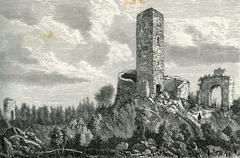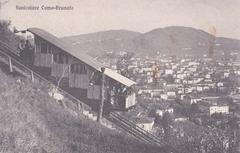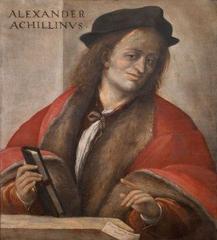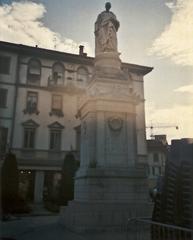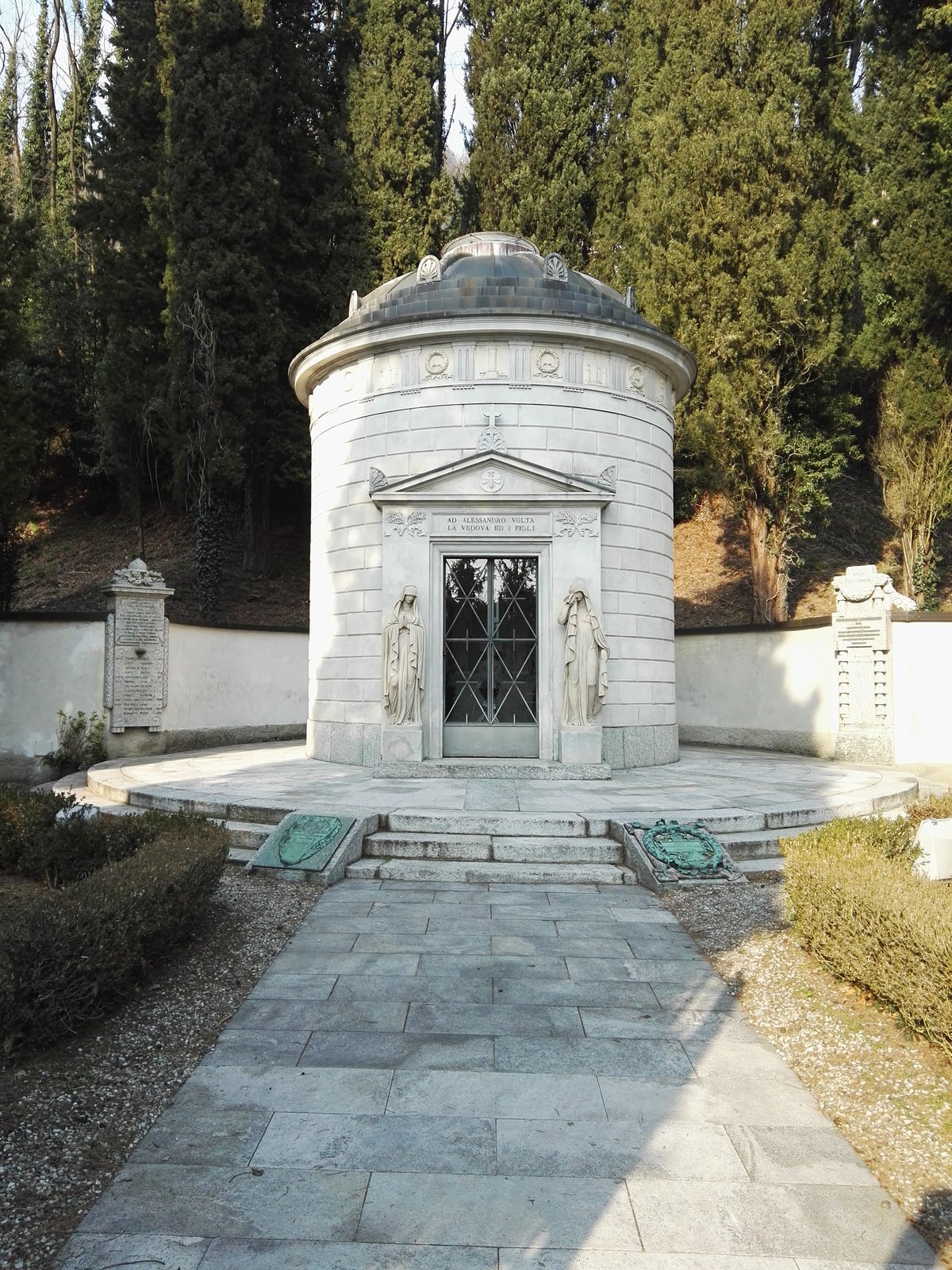
Tomb of Alessandro Volta: Visiting Hours, Tickets, and Comprehensive Guide to Como’s Historical Sites
Date: 14/06/2025
Introduction: Honoring Alessandro Volta in Como
Nestled in the picturesque city of Como, Italy, the Tomb of Alessandro Volta is a solemn and evocative memorial to one of science’s most transformative figures. Born in Como in 1745, Alessandro Volta’s invention of the voltaic pile—the first true electrical battery—revolutionized both the study and everyday application of electricity. Today, his legacy is deeply woven into Como’s cultural and architectural landscape. Visitors can explore not only his tomb in the tranquil district of Camnago Volta, but also the neoclassical Tempio Voltiano museum, the panoramic Faro Voltiano lighthouse, and the broader Volta Heritage Trail.
This guide provides a detailed overview for travelers and enthusiasts, covering visiting hours, ticketing, accessibility, and the significance of Volta’s sites in Como. Whether your interest lies in architecture, science, or history, you’ll find all the information needed to plan a meaningful trip. For the most current details, refer to official sources: (visitcomo.eu), (lakecomotravel.com), (Italy by Events).
Contents
- Introduction
- Early Life and Family Heritage
- Scientific Formation and Early Research
- Major Achievements: The Voltaic Pile
- Academic and Personal Life
- Visiting Volta’s Sites in Como
- Tempio Voltiano (Volta Temple)
- Faro Voltiano (Volta Lighthouse)
- Volta’s Birthplace and Tomb
- Practical Visitor Tips
- Commemoration and Cultural Legacy
- Volta’s Influence on Science and Society
- Frequently Asked Questions
- Neoclassical Design and Symbolism of the Volta Temple
- Visiting the Volta Temple: Hours, Tickets, and Access
- The Tomb of Alessandro Volta: Hours, Tickets, and Guide
- The Volta Heritage Trail
- Summary and Recommendations
- Sources
Early Life and Family Heritage
Alessandro Giuseppe Antonio Anastasio Volta was born on February 18, 1745, in Como, within the Duchy of Milan. His birthplace at Via Alessandro Volta 62 is marked with a commemorative plaque—an enduring link to his family’s noble Lombard roots (history-computer.com). Raised after his father’s early death by his uncle, the archdeacon of Como Cathedral, Volta’s childhood was shaped by both privilege and adversity. He attended the Jesuit School of Rhetoric and the Seminario Benzi, developing a passion for science and classical literature—despite familial pressure to pursue the priesthood or law.
Scientific Formation and Early Research
By sixteen, Volta committed himself to physics, conducting experiments in electricity and meteorology alongside his friend Giulio Cesare Gattoni. His curiosity and hands-on experimentation attracted the attention of leading European scientists, with whom he corresponded regularly (visitcomo.eu). Volta’s inventive spirit was evident in his custom-built instruments and his early studies of gases and atmospheric phenomena.
Major Achievements: The Voltaic Pile
Volta’s defining scientific contribution was the invention of the voltaic pile in 1800—the first continuous-source electrical battery. This device enabled sustained electric current, sparking a new era for scientific discovery and technological innovation. Volta’s announcement to the Royal Society and personal demonstration for Napoleon Bonaparte in 1801 marked pivotal moments in scientific history. His earlier identification of methane in 1776 further cemented his status as a pioneer, and the unit “volt” is named in his honor (visitcomo.eu).
Academic and Personal Life
Volta’s career was rooted in Lombardy. He held his initial professorship at Como’s Royal School (1774–1779), then taught at the University of Pavia for nearly 25 years (en.wikipedia.org). Despite his fame, Volta favored a quiet family life with his wife, Maria Teresa Alonsa Peregrini, and their three sons. He retired in 1819 to his Camnago estate, where he died in 1827 (history-computer.com).
Visiting Volta’s Historical Sites in Como
Tempio Voltiano (Volta Temple)
A neoclassical museum on the lakefront, the Tempio Voltiano houses Volta’s original instruments, personal effects, and awards. Open Tuesday–Sunday, 10:00 am–6:00 pm (closed Mondays), with general admission at €4 and discounts for students and seniors. The museum is wheelchair accessible, offers audio guides, and its Pantheon-inspired façade is a photographic highlight (Italy by Events).
Faro Voltiano (Volta Lighthouse)
Perched atop Brunate hill, the 29-meter Faro Voltiano, built in 1927, honors Volta’s centenary and provides panoramic views of Como and Lake Como. Access is via the Como–Brunate funicular followed by a scenic walk. Entry carries a modest fee; hours vary seasonally (lakecomotravel.com).
Volta’s Birthplace and Tomb
Volta’s birthplace at Via Alessandro Volta 62 is marked for exterior viewing; interior access is limited. His tomb, located in Camnago Volta, is a neoclassical monument set in a peaceful residential area. Admission is free, with opening hours from 8:00 am to 5:30 pm (April–September) and 8:00 am to 5:00 pm (October–March) (visitcomo.eu).
Practical Visitor Tips
- Tickets: Book Tempio Voltiano tickets online during peak times. The Tomb of Volta is free.
- Transport: Como is accessible via train and bus. Use the funicular for Brunate and local buses for Camnago Volta.
- Events: Volta’s birthday (February 18) and science festivals offer special programming.
- Accessibility: Central sites are accessible; the lighthouse and tomb may require moderate walking.
Commemoration and Cultural Legacy
Como celebrates Volta with statues, educational programs, and monuments like the “Life Electric” sculpture by Daniel Libeskind. His portrait appeared on the 10,000 lire banknote, and ongoing restorations ensure the preservation of his memory (en.wikipedia.org).
Volta’s Influence on Science and Society
Volta’s innovations underpin modern electrical science. The “volt” remains a universal unit of measurement, and his legacy persists in technological advancements and educational initiatives worldwide (visitcomo.eu).
Frequently Asked Questions (FAQ)
Q: What are the visiting hours for the Tempio Voltiano?
A: Tuesday–Sunday, 10:00 am–6:00 pm; closed Mondays.
Q: How much is admission to Volta’s museum?
A: General admission €4, with discounts available.
Q: Is the Tomb of Alessandro Volta free to visit?
A: Yes, admission is free.
Q: Are guided tours available?
A: Yes, especially at the Tempio Voltiano; check in advance for the tomb.
Q: Is the Volta Temple wheelchair accessible?
A: Yes, with ramps and accessible facilities.
Q: How do I reach the Tomb of Alessandro Volta?
A: By local bus, car, or a 45–60 minute walk/bike ride from Como’s center.
Neoclassical Design and Symbolism of the Volta Temple
The Tempio Voltiano exemplifies neoclassical architecture, modeled after the Roman Pantheon and inaugurated in 1928. Designed by Federico Frigerio, its grand Corinthian portico, marble columns, and domed hall reflect classical grandeur (Italy by Events). The interior’s 15 display cabinets showcase 234 artifacts, including early batteries and scientific apparatus, illuminated by a stained glass dome.
Located at the lake’s edge, the temple’s gardens and orientation create a harmonious blend with the urban and natural landscape. A recent restoration preserved its original features and enhanced accessibility.
The Tomb of Alessandro Volta: Visiting Hours, Tickets, and Visitor Guide
Location and Setting
Situated in the peaceful district of Camnago Volta, northeast of Como’s center, the tomb offers a tranquil atmosphere distinct from the city’s busier sites (lakecomotravel.com).
Architectural Features
Designed by Melchiorre Nosetti and inaugurated in 1831, the tomb’s neoclassical form and symbolic sculptures—depicting Religion and Science—pay homage to Volta’s legacy. Inside, a marble sarcophagus rests beneath a bust of Volta, with reliefs illustrating significant moments in his life (visitcomo.eu).
Opening Hours & Admission
- April 1 – September 30: 8:00 am–5:30 pm
- October 1 – March 31: 8:00 am–5:00 pm
- Admission: Free
Accessibility & Facilities
The site is generally accessible, though some uneven surfaces may be present. Facilities are limited; plan accordingly.
Getting There
Local buses connect Como’s center to Camnago Volta (15–20 minutes). Walking or biking takes 45–60 minutes through scenic areas. Limited parking is available (lakecomotravel.com).
Visitor Experience
The tomb is rarely crowded, offering a contemplative environment. Interpretation is mainly visual; consider using a guidebook or joining a local tour for deeper context.
Additional Tips
- Combine your visit with other Volta sites for a fuller experience.
- Early morning or late afternoon visits offer the best light and tranquility.
- Dress modestly and bring water/snacks if traveling from the city center.
The Volta Heritage Trail: Exploring Como’s Scientific Landmarks
The Volta Heritage Trail links key sites celebrating Volta’s legacy:
- Tomb of Alessandro Volta: Neoclassical monument in Camnago Volta (visitcomo.eu).
- Tempio Voltiano: Lakefront museum with original instruments.
- Life Electric Monument: Modern sculpture symbolizing electrical energy.
- Faro Voltiano: Lighthouse with panoramic views, accessible via funicular and hike.
- Birthplace and Early Life Sites: Marked locations, including Via Volta 62 and the Church of San Donnino.
- Piazza Volta & Monument: Central square with statue by Pompeo Marchesi.
- Liceo Classico Alessandro Volta: Historic school where Volta taught.
Most sites are walkable from the city center; others require bus, funicular, or a short drive (lakecomotravel.com, visitcomo.eu).
Summary and Visitor Recommendations
The Tomb of Alessandro Volta and Como’s related historical sites offer a journey through the remarkable achievements of a scientific pioneer. The tomb’s serene setting, the Tempio Voltiano’s interactive exhibits, and panoramic landmarks like Faro Voltiano together provide a comprehensive view of Volta’s legacy. With free or affordable admission, accessible locations, and a rich program of educational events, these sites are ideal for science enthusiasts, history lovers, and travelers alike.
For the best experience, check official websites for current hours and ticket policies, and consider using multimedia guides or joining a local tour. Stay informed about special events via social media and Como’s cultural channels. Your visit will not only honor Volta’s enduring influence but also immerse you in the beauty and heritage of Lake Como (visitcomo.eu, lakecomotravel.com, Italy by Events).
Sources and Further Reading
- visitcomo.eu: Alessandro Volta’s Legacy in Como
- Italy by Events: Visiting the Volta Temple in Como
- visitcomo.eu: Tomb of Alessandro Volta Guide
- visitcomo.eu: The Volta Heritage Trail
- lakecomotravel.com: Volta Tour and Historical Sites

